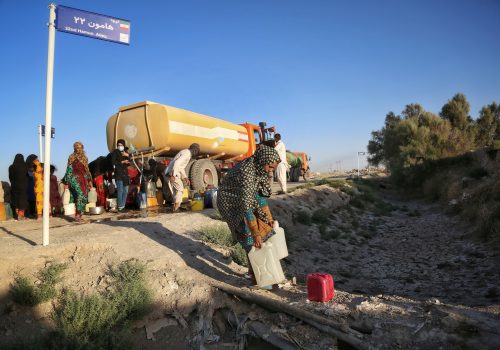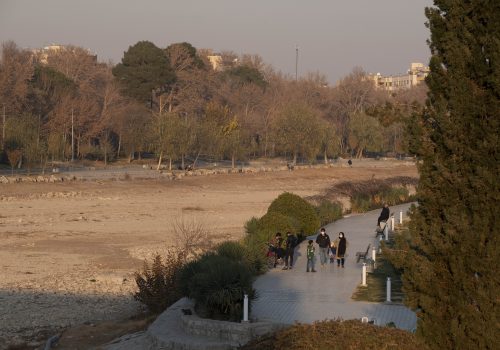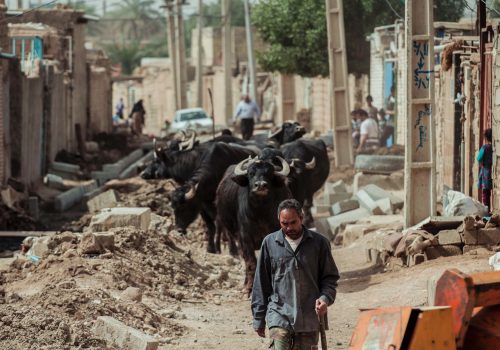A thirsty reality: Iran’s dire water situation
Despite climate warnings since 1988, Iranian officials have consistently ignored regional environmental concerns, especially following the Iran-Iraq war (1980-1988). For example, they prioritized dam construction and increased groundwater extraction for food self-sufficiency, disregarding environmental impacts. Former Agriculture Minister Issa Kalantari is now warning of irreversible groundwater depletion, with an annual deficit of over 30 billion cubic meters (BCM). This acknowledgment raises concerns about the sustainability of Iran’s current water management practices, particularly when hundreds of dams constructed after the war are not in good condition.
During Iran’s population surge—ten to over eighty-five million over the course of a century—its renewable water resources have gone from 130 BCM to 80-85 BCM. Projections indicate a potential halving of resources by 2041, raising concerns as Iran’s population is expected to surpass 100 million. Per capita water availability for Iranians may drop below 500 cubic meters, marking absolute scarcity. Once adept at groundwater management, Iran now faces consequences like land subsidence due to depleting groundwater, which affects food self-sufficiency. This has led to farmers abandoning lands, causing an influx of ten million people into the outskirts and shanty towns since 2013—ten times the number of Syrian villagers migrating during the 2006-2009 drought in the Hasakah governorate. Many researchers have linked the Syrian conflict to this drought.
Regardless of the numerous opportunities to enhance its water management policies, the government persistently adheres to the path of Iran’s “Water Mafia”—a non-official alliance that comprises the energy ministry, executives, academics, consulting engineers, influential contractors, and a cadre of Islamic Revolutionary Guard Corps (IRGC) commanders overseeing the Khatam al-Anbiya Construction Headquarters. Disturbingly, if this group opts to construct a dam like Gotvand—where a multimillion-ton mass of salt became a part of the reservoir despite many warnings about this possibility due to nearby saline geological formations—there seems to be no governing authority capable of halting their actions.
The concept of top-down decision-making in Iran is not novel; Iranians have been acquainted with such a system for centuries. However, the adverse effects of water mismanagement have never wrought such devastation on the land and its water resources (the latter of which are steadily diminishing). Since the 1980s, when President Ali Akbar Hashemi Rafsanjani’s post-war reconstruction plans garnered substantial attention, the landscape of Iran has been transformed by the construction of numerous dams along rivers, absorbing considerable financial resources over time.
In the late 1980s, the establishment of two key organizations—the Khatam al-Anbiya Construction Headquarters, equipped with significant machinery and war-acquired experience, and the Iran Water & Power Resources Development Company (IWPC)—resulted in an enduring business alliance. IWPC was founded by a group of engineers, mainly consisting of the students who occupied the US Embassy in Tehran. During Rafsanjani’s era and beyond, those entrusted with managing water and agriculture, despite warnings from experts, advertised that constructing dams and transferring water between watersheds would guarantee self-sufficiency. However, these decisions, made without consultation with independent and qualified experts, led to a decline in lakes, wetlands, rivers, and groundwater sources.
Social impact
In 2016, many believed that a successful nuclear agreement and the lifting of sanctions would allow the Islamic Republic to address its financial challenges, solve the water crisis, and rehabilitate its endangered lakes and rivers. The Center for Naval Analysis, an institute in Washington, later warned the US government of escalating and enduring water tensions that could lead to local protests, potentially sparking violence worldwide and undermining US national interests. The report also highlighted the possibility of global terrorism and civil war over shared resources. This warning gained attention in December 2017-January 2018 during an unexpected uprising in Iran that reverberated across the nation—the largest at the time since the 1979 revolution. Thousands protested, leading to swift intervention from security forces. Official reports acknowledged over twenty casualties, with unofficial sources suggesting the death toll exceeded fifty. The critical aspect was that protestors lost their lives in towns that were struggling with the harsh impacts of water scarcity.
In 2019, the nation witnessed another widespread uprising, with reports indicating that over 1,500 protestors lost their lives at the hands of security forces. In Mahshahr, a town in the Khuzestan province in southern Iran, and other towns, individuals affected by the regime’s detrimental water policies were fatally shot. The unrest persisted into 2020 and 2021, as people in Khuzestan clashed with security forces over water-related issues, resulting in further loss of lives. Despite being considered a water-rich province, with major rivers like Karun, Karkheh, and Jarrahi, and possessing vast oil and gas reserves, Khuzestan has tragically become a victim of poor water management. Many rivers and marshes in the region have dried up due to the water management schemes implemented by the government and the Khatam al-Anbiya Construction Headquarters.
Amidst the desiccation of wetland areas—exemplified by Hoor-al-Azim in Khuzestan—intricate sediment deposits have become susceptible to the elements. With even the faintest breeze, these minuscule particles ascend into the air, launching as dust storms that target the cities within the province. This matter has engendered a noteworthy deterioration in air quality across various sectors of Khuzestan, concurrently fostering the widespread illness of thousands of residents in the province.
Inequities in Iranians’ access to water
Iran’s uneven water rights approach disproportionately impacts citizens in marginalized provinces, causing severe water scarcity. Provinces like Sistan and Baluchistan, Kerman, Fars, Isfahan, Southern Khorasan, Hamedan, Yazd, Khorasan-e Razavi, and Semnan face widespread water poverty due to disappearing lakes, groundwater depletion, and contamination. Projects like the Karun-3 dam and the Khersan-3 dam, as well as water allocation, displace residents, resulting in enduring hardships. On top of this, climate change and vanishing glaciers intensify water losses in different river basins. Inter-basin water transfers fuel further tension, benefiting lobbyists and the Water Mafia while simultaneously exacerbating environmental injustice against marginalized populations. Despite government assurances, residents of Zayandeh Rud basin resort to illegal well pumping, causing groundwater depletion, land subsidence, and health issues, threatening Isfahan’s existence. In northern Iran, Lake Urmia has dried up due to dam construction and unsustainable farming, leaving behind a saline desert filled with residues and particles contaminated by industrial and human wastewater and chemical fertilizers. Strong winds disperse these toxic particles, harming millions in nearby areas.
Despite the evidence of human and environmental damage from expensive water management projects, it has been empirically proven that, in many regions of Iran, nature-based solutions—unlike dam constructions and inter-basin water transfers—are more efficient and cost-effective. But Iran’s Water Mafia consistently opposes projects prioritizing efficiency and cost-effectiveness, as these initiatives undermine their ability to extract commission money.
SIGN UP FOR THE THIS WEEK IN THE MIDEAST NEWSLETTER
Nowadays, IRGC generals and water executives have fallen in love with seawater desalination, a technology practiced mainly by Israel and nations in the Persian Gulf region. As FAO’s Slim Zekri told me, the production cost of one cubic meter of freshwater in the Persian Gulf is approximately $1. However, an insider in Iran revealed to me that the actual cost of freshwater production in the country exceeds $1.5. This is influenced, in part, by sanctions and the absence of a direct business relationship with Israel, which is the proprietor of Reverse Osmosis (RO) technology and the primary manufacturer of RO filters. The expense of transporting this water through a pipeline to central Iran, nevertheless, significantly escalates the overall cost to almost $5 per cubic meter.
The harmful impact of desalination plants is not often disclosed to the Iranian public. The hot brine is disposed of in the shallow Persian Gulf, leading to an environmental massacre. Many fish species have migrated from the extremely saline waters and coral reefs are experiencing bleaching and dying. In some circles, it has been said that the price tag of establishing this infrastructure and its pipelines is over $8 billion, and that it would produce a minimal amount of freshwater—approximately 4 BCM per year in 2044.
Iranian experts have developed cost-effective methods to manage flash floods and recharge aquifers by storing water underground, potentially saving at least 30 BCM annually at a cost of less than $8 billion. With an anticipated cost of nearly $500 per hectare for implementation, the execution of this project over a 14-million-hectare area would result in an expenditure of approximately $7 billion. Additionally, the resulting annual water storage capacity would surpass 40 billion cubic meters, even in a dry year. This approach would inspire a reverse migration among farmers and the reclamation of ancestral lands. Surveys suggest it can be implemented on nearly 8 percent of Iran’s land, providing water savings and flood protection while positively impacting microclimates.
Empowering farmers to establish floodwater management co-ops safeguards resources, mitigates destructive floods, and ensures water storage. The positive environmental impact of artificial recharge and spate irrigation, which would provide an extra 50 percent to Iran’s annual renewable water resources, stands in contrast to desalination’s minimal water addition and environmental drawbacks. Despite viable alternatives, regime insiders choose to sacrifice natural resources for a slight commission increase from an $8 billion project.
How can the United States help?
Compelling data underscores the dire situation facing millions of rural Iranians, pushing them to abandon their ancestral lands due to a substantial decline in groundwater resources. Projecting forward, if current climate conditions persist and water management remains inadequate, a mass exodus appears imminent. This demographic shift could significantly impact the United States’ interests and security concerns in the Middle East and beyond. In recognizing Iranians as potential allies, the United States could prioritize their well-being in alignment with its national interests. Transforming Iran’s water situation necessitates a fundamental shift towards a democratic system that values knowledge and encourages active public participation, departing from the prevailing top-down decision-making model.
The United States can help Iranians through technical assistance and knowledge transfer, capacity building and training, and supporting civil society as well as promoting climate change adaptation.
For Iranians, learning from Israeli water experts and the authorities who established Israel’s national water company (Mekorot) in 1937—a centralized body predating the nation’s formation by eleven years—is imperative. Such an entity should possess the capability to address the challenges posed by a changing climate, fostering resilience in Iran while concurrently navigating diplomatic intricacies related to shared water resources with neighboring nations. This approach aims to alleviate tensions and initiate regional cooperation within the Middle East and North Africa region. The United States has the ability to financially support the establishment of an organization like Mekorot situated outside of Iran. This organization, once operational, could initiate the implementation of modified water management methods, effectively alleviating damages resulting from the mismanagement of the Islamic Republic. Strategic intervention of this nature can contribute to achieving a state of relative stability following the possible decline of the Islamic Republic.
The pursuit of sustainable improvements in Iran’s water management requires a concerted effort toward capacity building in civil society and water-dependent sectors. American institutions, drawing on successful initiatives predating 1979, are well-positioned to play a pivotal role in this regard. Despite historical criticisms of Truman’s Point 4 Program and Iran’s adoption of the American “Hydraulic Mission,” a tailored sustainable development approach is crucial. Oversight by Iranian-American academics, who are well-versed in Iran’s environmental challenges, can ensure the effectiveness of these initiatives. Renowned figures in the agricultural and water sectors within the Iranian community can serve as exemplars, showcasing successful practices applicable to diverse regions in Iran. Disseminating knowledge through online training courses, television programs, and instructional animations demonstrating sustainable solutions can help diminish reliance on the authoritarian governance of the Islamic Republic. Foreseeing potential uprisings in Iran, particularly arising from water and environmental crises, emphasizes the need to promote democratic practices in the agricultural and environmental sectors. In early 2024, severe air pollution led to school closures in major cities, prompting protests in Ardekan and Arak against regional pollution linked to local and national industrial policies. The substantial decline in rainfall and snowfall heightens the imminent risk of severe water shortages in the upcoming spring and summer, which suggest a likely escalation in protests and instability based on historical trends.
The prevailing patriarchal system in Iran has hindered genuine democratic experiences, impeding accountability for officials and elites. In contrast, the US environmental management evolution, driven by civil society activism, led to the creation of the Environmental Protection Agency and pivotal legislation like the Clean Water Act. This empowered communities to influence projects, challenging top-down decision-making. The evolving social landscape in Iran provides an opportunity to transmit the experiences of American groups effectively. This would enable Iranians to envision impactful changes through civil means in their protests, aligning with the democratic values witnessed in US environmental governance.
Sharing knowledge builds trust and fosters cooperation and partnership between Iranians and Americans in alignment with US national interests, especially in the Persian Gulf region. While US institutions have shared rainfall and groundwater data with Iranian scientists, expanding these efforts is crucial. Disseminating valuable information to farmers, stakeholders, and shareholders in Iran is vital for informed decision-making and sustainable practices in water and environmental management. Addressing financial constraints for talented Iranian students is essential and would empower them to study under top Iranian-American academics, facilitating knowledge exchange on updated water management methods. This collaborative effort within academia has the potential to significantly impact water and environmental management in Iran, contributing to the preservation of natural resources.
In a warming climate with a deteriorating water situation, Iran confronts declining livelihoods due to the Islamic Republic’s poor management, prompting potential mass migration and instability. Despite Iranians’ inclination to engage with the United States, a human-made drought affects them. In the post-Islamic Republic era, Iranians require the United States to be a reliable partner to navigate challenges while respecting integrity and choices. This partnership, which is crucial for US national security, should begin sooner rather than later. Iranian experts are prepared to establish their Mekorot today and initiate planning for a new environmental system to address resource mismanagement.
Nik Kowsar is an Iranian-Canadian water issues analyst. He produces and hosts a weekly TV show addressing Iran’s water situation, broadcast on several satellite TV channels. Follow him on X: @nikahang.
Further reading
Fri, Jul 7, 2023
Iran and Afghanistan are feuding over the Helmand River. The water wars have no end in sight.
IranSource By Holly Dagres
Fatemeh Aman, a non-resident senior fellow at MEI, on why the Islamic Republic and Taliban are bumping heads on transboundary water issues.
Fri, Apr 21, 2023
Springtime in Iran signals the renewal of an environmental movement
IranSource By
Although there has been a decline in the size and frequency of protests in recent months, the onset of Spring serves as a reminder that the goals of the Woman, Life, Freedom movement are perennial.
Fri, Jul 30, 2021
The grapes of Khuzestan’s wrath
IranSource By
After decades of poor environmental governance and mismanagement of water resources in Iran’s southwestern Khuzestan province, it’s not surprising that people have taken to the streets once again since July 15, prompting a violent crackdown by security forces and near total internet shutdown.
Image: A boy stands in front of old and abandoned boats where there was once a lake. The Iranian province of Sistan and Baluchistan is affected by drought and water shortages. Scorching heat, drought and sandstorms plague residents in the border region between Afghanistan and Iran. At times, water in the provinces is so scarce that it is brought to villages by tanker trucks. Now the region became the scene of a bloody skirmish in late May, when an exchange of gunfire turned the border region into a battlefield. Just days earlier, Iran's President Ebrahim Raisi had threatened the Taliban in a dispute over the water of an important border river. (to dpa "Dispute over water - neighboring states between peace and conflict") via Reuters


